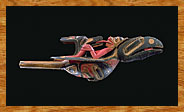
 Clothing Clothing
 Headresses Headresses
 Raven Rattles Raven Rattles
 Copper Shields Copper Shields |
Raven Rattles
Another standard accoutrement of a north coast chief was a pair of Raven rattles. The basic form is that of the Raven holding a small object in its beak, in reference to the Raven's bringing sunlight to mankind. On the Raven's breast is a flat design image of Konankada. Up to this point of comparison, the symbols are parallel to those of the Chilkat blanket: that is, the image of Raven centred by that of Konankada. The symbolism of the Raven rattle, however, elaborates upon this basic reference to the first potlatch. On the Raven's back is a small human, whose extended tongue is joined to that of a woodpecker type of bird.
Many rattles have a Frog in the place of the woodpecker, and on some, the Raven even holds a Frog in its beak in place of the sun. This may be a mythic reference to the blind Frog People who lived at the mouth of the Nass River and whose plight prompted Raven to steal the sun.

 |
Raven rattles such as this one were used by a chief in ceremonies. The different sounds and rhythms produced by a pair of such rattles enhanced the drama of his oratory. On this rattle, the Raven supports a shaman initiate who is drawing inspiration and knowledge from the animal world through the link between his tongue and that of a mythical bird.
Collected on Haida Gwaii (probably Skidegate) in 1876 by Lord and Lady Dufferin.
CMC VII-C-2149 (S85-3308) |

These rattles are complex in their meaning and as yet have not been fully decoded. A possible clue is provided by the Tsimshian myth about the Raven who returns to earth after stealing the sun from the Sky Chief and lands on his back in Prince Rupert harbour (where a large petroglyph marks the spot). The Raven is freed from the rock by a flicker, which uses its sharp tongue to free it. Another Tsimshian myth tells of how the first Raven rattle was brought up on the hook of a fisherman from the Skeena River; from there, its use spread to other people on the north coast. The Haida themselves have no such origin myths and probably received the Raven rattle through prehistoric trade with the mainland.
Raven rattles were usually used in pairs, which associates them with ceremonies elsewhere on the coast to mark the start of salmon runs into the rivers. The swishing noise of the rattles is said to sound like the fins of salmon breaking the surface of the water, which encourages the fish to come past the villages.
|